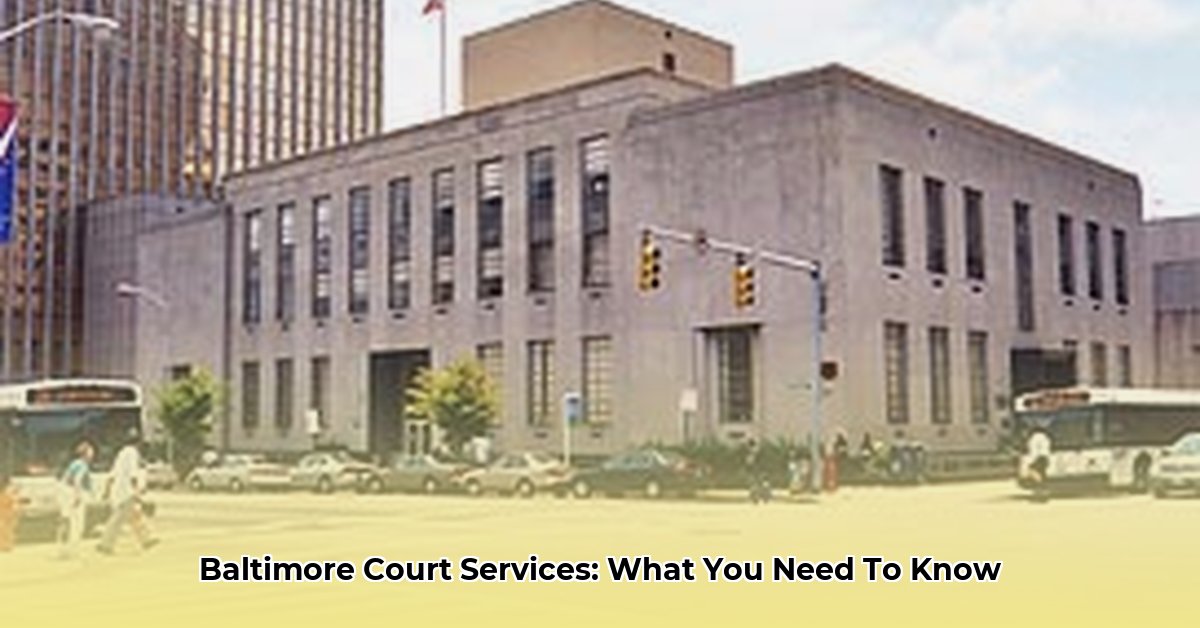
Navigating the legal system can be daunting, but understanding the process makes it significantly easier. This guide focuses on the Baltimore City District Court, located at 501 E Fayette Street, explaining its services, accessibility, and potential challenges. We'll provide a step-by-step action plan to help you navigate your legal matters confidently.
What Happens at 501 E Fayette Street?
The Baltimore City District Court at 501 E Fayette Street primarily handles less complex cases. These include misdemeanors (less serious crimes), a subset of felonies (more serious crimes), and civil disputes (disagreements between individuals or businesses) involving amounts up to $30,000. A key distinction: this court does not conduct jury trials, leading to generally faster case processing. Do you need to understand the difference between a misdemeanor and a felony? Many online legal resources can clarify this distinction.
Getting There and Getting Help
Locating the courthouse is straightforward; online maps readily provide directions via I-695, public transportation, or on foot. However, accessibility remains a concern. Lack of personal transportation or reliable public transit access presents a significant barrier for some individuals. The court offers an in-person help center, providing assistance with navigation and procedural understanding. Phone and online chat support are also available. Specialized assistance is offered for individuals with disabilities. While these options are helpful, expanding online services – such as online forms and appointments – would significantly enhance accessibility. Is having more online services a priority for court improvements? Many citizens believe this would significantly help.
Potential Roadblocks and How to Avoid Them
While the help center is valuable, its capabilities are limited. It cannot provide legal advice, and assistance might be unavailable for businesses, family members acting on behalf of others, or those facing specific legal issues. Understanding these limitations is crucial. Furthermore, the court's online presence could be significantly improved. A more user-friendly website with readily available forms and schedules would greatly simplify the process.
Making the Most of the Court's Resources: Your Action Plan
Here’s a step-by-step guide to effectively navigate the 501 E Fayette Street courthouse:
- Explore Online Resources: Begin by checking the court's website for potentially helpful information. (While limited, it's a good starting point.)
- Contact the Help Center: For personalized support, reach out to the help center via phone or chat.
- Plan Transportation: Ensure reliable transportation to the courthouse.
- Gather Documents: Organize all necessary paperwork beforehand to streamline the process.
Suggestions for Improvement: A Collaborative Roadmap
The Baltimore City District Court, like any system, can be continually improved. Several key areas warrant attention:
- Enhanced Website: A more user-friendly website with FAQs, an online appointment scheduler, and clearer procedural guides is essential. This would significantly improve the user experience.
- Community Outreach: Increased community outreach, particularly to underserved areas, ensures equitable access to legal services.
- Improved Accessibility: Prioritizing accessibility for individuals with disabilities is paramount.
Areas for Improvement: A Collaborative Roadmap
| Stakeholder | Short-Term Goal (Next Year) | Long-Term Vision (3-5 Years) |
|---|---|---|
| Court Administration | Website revamp with FAQs and improved navigation; downloadable forms. | User-friendly online portal for case tracking and scheduling; secure online payments. |
| Help Center Staff | Regular community outreach; active promotion of resources. | Partnerships with community organizations to expand legal service access; specialized assistance. |
| Maryland Judiciary | Analyze transportation barriers and propose solutions; translation services. | Improved digital infrastructure and community-based legal aid programs. |
| Individuals Needing Help | Actively seek online information; utilize help center resources; seek legal aid if needed. | Advocate for improved accessibility and streamlined processes; participate in community outreach. |
By understanding the court's services and planning accordingly, you can navigate the 501 E Fayette Street courthouse more effectively. Remember, accessing justice shouldn't be daunting; preparation can significantly improve the experience.
Accessing Maryland District Court Services Online
Maryland offers online court services, enhancing access to information and legal processes. While electronic filing is currently limited to Prince George's County, statewide expansion is a key goal. Digital literacy is crucial for successful online engagement; security and user privacy are paramount considerations. Are you aware of the importance of digital literacy in accessing online court services? Many people are unaware of how crucial it is.
Navigating Online Resources
The Maryland Judiciary website (https://www.courts.state.md.us/eservices) serves as the central hub for online resources. It provides access to information, court records (limited to appellate court opinions since 1995), and online payment options for many fines and fees. Note, however, that not all courts and processes are fully online.
Limitations of Online Services
Remember that electronic filing isn't available statewide, and access to all court information online is not yet a reality. Some processes still require in-person visits.
Tips for Online Success
- Use the official Maryland Judiciary website as your starting point.
- Be patient and persistent – learning the online system takes time.
- Check the specific court's website for individual capabilities and functionalities.
- Ensure a strong and stable internet connection.
The Future of Online Court Services
Maryland’s court system is working towards a fully integrated electronic system, promising improved efficiency and accessibility. However, full implementation requires significant time and resources, and challenges remain in addressing digital literacy gaps. The system's success depends on ongoing collaboration and resource allocation.